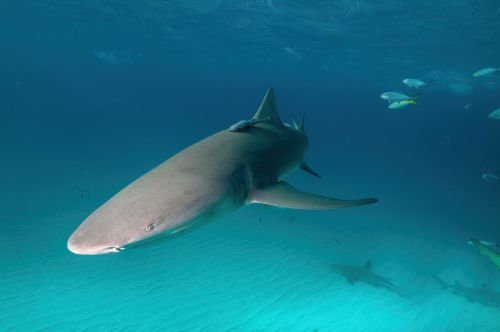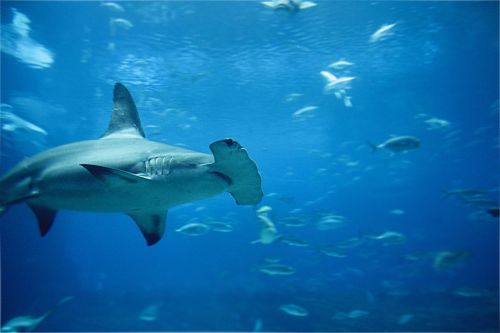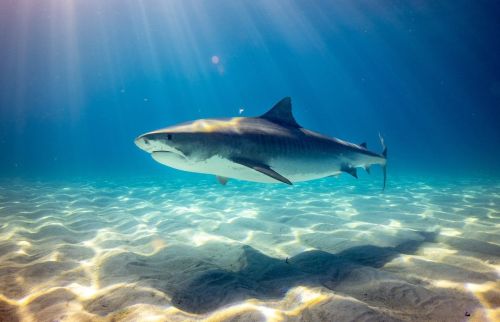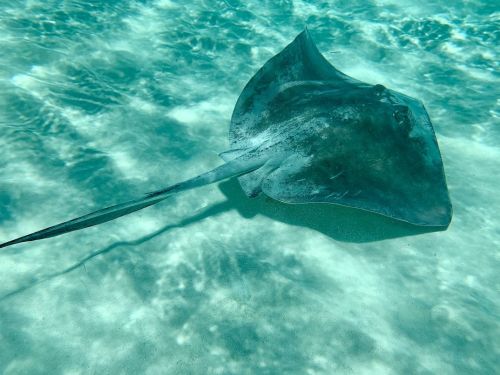The basking shark is the second largest known fish in the world after the whale shark. Its body length is impressive, reaching ten meters, and its weight ranges from four to six tons. However, this giant is a harmless fish, as it feeds exclusively on zooplankton. It moves calmly, filtering hectoliters of seawater with its huge mouth.
Cartilaginous fishes are a cluster of aquatic vertebrates that includes chimaeras, rays and sharks - a total of about 1,200 species.
The fossil record shows that the existence of sharks has been dated to more than 400 million years ago, rays most likely appeared 200 million years ago, and chimeras about 360 million years ago.
Along with the whale shark (Rhinocodon typus) and the megamouth shark (Megachasma pelagios), it is a plankton-eating species.
As an adult, the basking shark usually reaches a body length of 6.70 to 8.80 meters, but can reach 10 meters or more. The largest recorded individual measured 12.27 meters and was caught in a herring net in the Bay of Fundy in Canada in 1851. The weight of this fish exceeded 9 tons.
Basking sharks weigh approximately 5.2 tons.
The basking shark's body coloration is almost monochromatic - dark gray, gray-brown to black, with the back darker than the underside. There are often light or dark patches on the back, sides of the body and under the head.
The underside of the fins is also dark gray, but in juveniles the fins are white with a clear delineation of dark areas. In very rare cases, basking sharks can develop albinism.
It has two dorsal fins, the first of which, shaped like an almost regular isosceles triangle, is noticeably longer than the second. The base of the first dorsal fin is in front of the base of the ventral fins. The second dorsal fin is almost opposite the anal fin and almost equal in size.
The caudal fin is crescent-shaped.
They encircle its body behind its head like a collar and almost meet at the top and bottom.
For this reason, they are often confused with the great white shark. However, they differ in the shape of the jaw, which in the basking shark is cave-shaped, up to 1 meter wide, equipped with 4-9 rows of fine, conical modified teeth located in the mucosa. The total number of teeth can be up to 3,000.
To obtain food, they often swim below the surface with their mouths wide open. As they swim slowly, they filter plankton out of the water, which is caught in the weirs of their gills and then ingested. Zooplankton, mainly copepods, are captured in mucus-covered teeth that are flushed into the esophagus when the mouth is closed.
The basking shark is the only type of filter-feeding shark that feeds without ingesting water, simply by passing a current through its throat.
It is capable of filtering approximately 1800-2000 tons of water per hour.
At times, there can be an aggregation of more than 100 sharks. They move slowly, filtering plankton, extending their dorsal fin out of the water and even flipping their bellies. These fish swim at a speed of about 3.7 km/h and do not tend to swim away from approaching vessels.
These jumps may be an attempt to rid their bodies of ectoparasites, including sea lampreys that bite into the shark's skin without penetrating it. Basking sharks are also attacked by the cookiecutter shark (Isistius brasiliensis), which uses its teeth to bite off pieces of flesh from large fish and marine mammals.
They are known to be attacked by orcas, but few predators hunt these sharks. There is some information that great white sharks feed on the carcasses of basking sharks.
The embryos feed on egg yolk and there is no placental connection to the mother. The number of litters and the size of the newborns are unknown, but the gestation period is thought to be between 1 and 3.5 years.
Males probably reach sexual maturity at 4-5 meters in length, corresponding to an age of 12-16 years. Females mature at 8.1-9.8 meters.
Basking sharks have an average life span of about 50 years.
They allow divers to approach them at close range. However, humans do pose a threat to basking sharks. Historically, this species was considered a valuable food fish due to its slowness, lack of aggression and abundance. The catch of these fish reached its peak about 100 to 150 years ago. They were hunted for the fat extracted from their livers - a medium-sized shark yielded 300 to 800 liters of fat, and in some cases more than 2,000 liters, as the huge liver of the basking shark contains up to 60% fat. They were hunted with a harpoon.
Today, the need for basking shark fat has greatly declined.
Due to its slow growth, long gestation period, low reproductive rate and late sexual maturity, the species is not able to recover quickly, so it was deemed necessary to surround it with protection. The species was added to the Red List of Threatened Species in 2005. It is currently classified as endangered.











